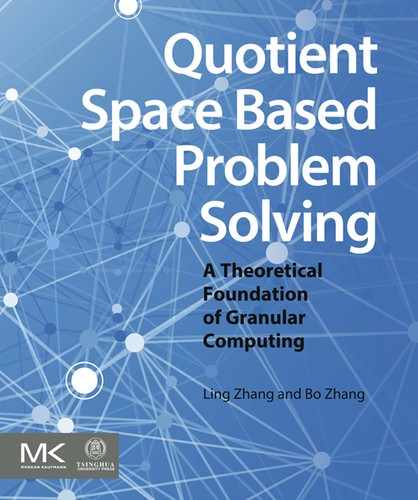The Expansion of Quotient Space Theory
Abstract
In this chapter, we extend the quotient space theory to general cases. It includes two aspects. First, the falsity- and truth-preserving principles are extended to a general quotient space approximation principle. Second, the quotient space theory based on equivalence relations is extended to that based on tolerant relations and closure operations.
When transforming a solution in the original space to a solution in its quotient space, or vice versa, a precise quotient space should be constructed. This is a problem-dependent work. Therefore, we present a general principle, the quotient space approximation principle. By the principle, a set of quotient spaces is constructed to approximate the original space. Then, the solution (or performance) of the original space is estimated from the solutions (or performances) of the quotient spaces. This is just the well-known multi-resolution system analysis and the multi-granular computing.
Since the quotient space approximation is a multi-resolution analysis method, it is closely related to wavelet analysis. Its connection to the second-generation wavelet analysis is discussed. Meanwhile, the concepts of quotient space and fractal geometry have a close relation. We also discuss the relation using the quotient space approximation principle.
Our original quotient space theory is based on equivalence relations, i.e., the boundaries of domain objects are clear-cut. In the chapter, it is extended to structures induced from closure operations and the tolerance relations. We also show that many useful properties in the original theory are still available under the expansion.
Keywords
closure operation; fractal geometry; quotient space approximation; wavelet analysis; tolerant relationChapter Outline
7.1 Quotient Space Theory in System Analysis
7.1.2 Quotient Space Approximation Models
7.2 Quotient Space Approximation and Second-Generation Wavelets
7.2.1 Second-Generation Wavelets Analysis
7.2.2 Quotient Space Approximation
7.2.3 The Relation between Quotient Space Approximation and Wavelet Analysis
7.3 Fractal Geometry and Quotient Space Analysis
7.3.2 Iterated Function Systems
7.4 The Expansion of Quotient Space Theory
7.4.2 Closure Operation-Based Quotient Space Theory
7.4.3 Non-Partition Model-Based Quotient Space Theory
7.4.4 Granular Computing and Quotient Space Theory
7.4.5 Protein Structure Prediction – An Application of Tolerance Relations
7.1. Quotient Space Theory in System Analysis
7.1.1. Problems
7.1.2. Quotient Space Approximation Models
1. The Performance Description
2. The Convergence of a Set of Quotient Spaces
Definition 7.1
Definition 7.2
Definition 7.3
3. Performance  of system X
of system X
Definition 7.4
Definition 7.5
Definition 7.6
Definition 7.7
Proposition 7.1
Proof
![]()
![]()
Example 7.1
Definition 7.8
Proposition 7.2
Proof
![]()
![]()
